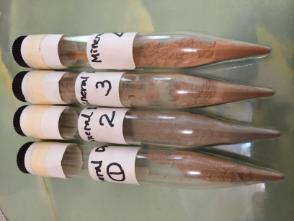Heterogeneous reactions on mineral dust particles
Mineral dust particles are one of the largest contributors to particle mass loading in the ambient atmosphere, with estimated annual emission of 1000−3000 Tg yr. The Gobi desert in Mongolia and northern China and the Sahara desert in Northern Africa are the most important sources of mineral dust particles. In arid environments such as the Southwestern U.S., eolian processes also cause soil erosion, transport mineral dust, and deposit the dust on surfaces where it may intrude. Mineral dust has a wide impact on the Earth System by affecting visibility degradation, the radiative forcing, cloud formation, plant nutrition, and oceanic biogeochemical cycles. During long-range transport, dust particles provide significant surfaces for the heterogeneous reaction with atmospheric trace gases such as SO2, O3, NOx, H2O2, and hydrocarbons. The photocatalytic ability of airborne mineral dust particles is known to heterogeneously promote the oxidation of air pollutants, but its prediction is not fully taken by the current models.
What is our laboratory doing?
- The impact of authentic mineral dust particles sourced from the Gobi Desert (GDD particles) on the kinetic uptake coefficient of SO2 has been comprehensively studied under varying environments (humidity, O3, NOx) using the indoor chamber and the UF-APHOR chamber.
- The Atmospheric Mineral Aerosol Reaction (AMAR) model was developed to capture the influence of air-suspended mineral dust particles on the formation of nitrate and sulfate under various environments.
- Application of the AMAR model to regional scale models

